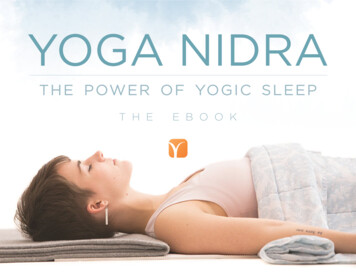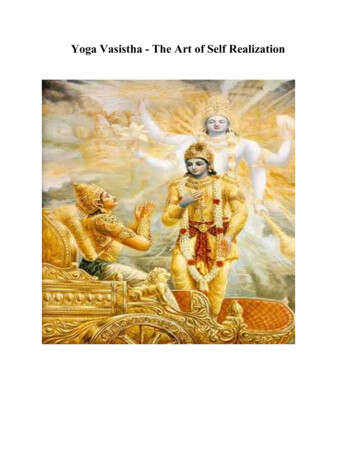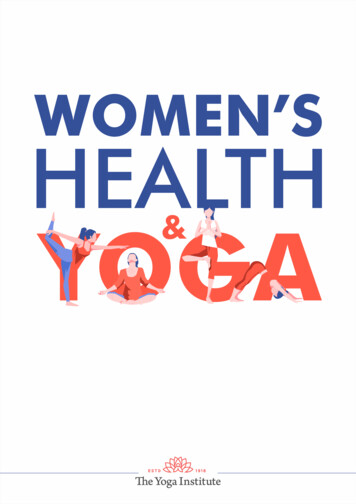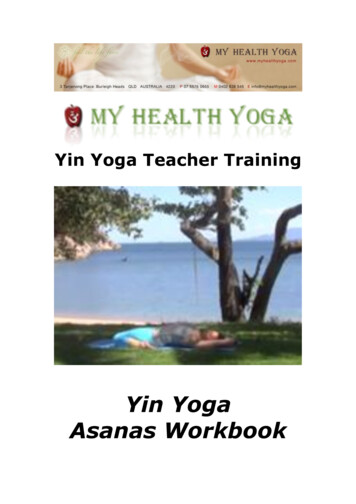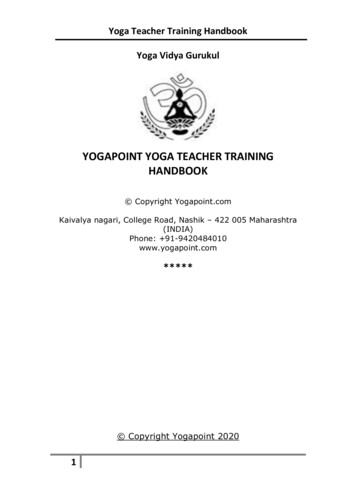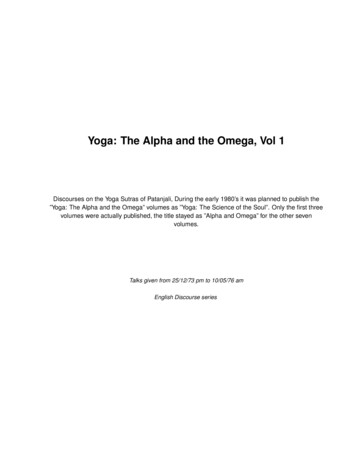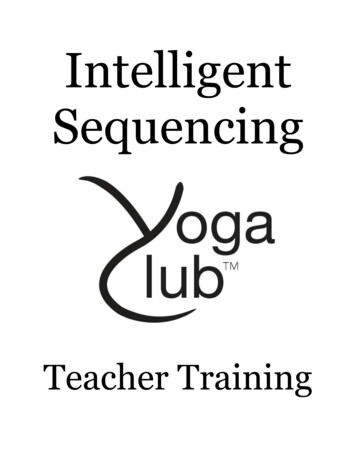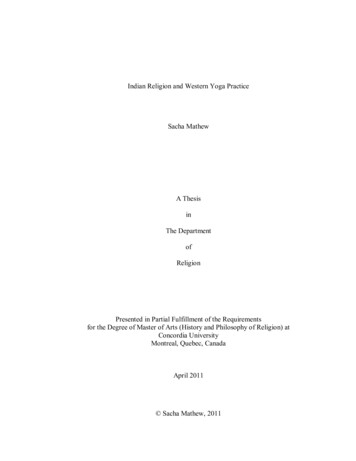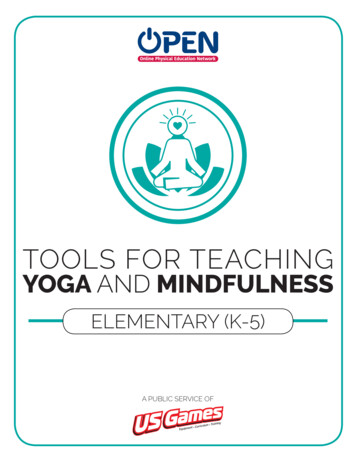
Transcription
TOOLS FOR TEACHINGYOGA AND MINDFULNESSELEMENTARY (K-5)A PUBLIC SERVICE OFainingulum Trt CurricEquipmen
Create by:Victoria Otto, Verneda Edwards, Megyn Taback, Daniel Hill, Rich WilesSpecial Contributions by:Aaron Hart, Deedi Brown, Mike MartinezDesign:Jennifer Truong, James Boland, Aaron HartIn partnership with the SUNY Cortland AMP Lab.OPEN is a Public Service Organization supported by US Games and BSN Sports. 2019These documents and all of the content provided by OPEN are available to all teachers, coaches andactivity leaders without cost or obligation. Please print, copy, and share the content responsibly. Thesale of this work by a third party is prohibited in any print or electronic format.Grade-Level Outcomes for K-12 Physical Education are used under license from SHAPE America. SHAPE America, 2013, www.shapeamerica.org. All rights reserved.
Written By: Victoria Otto, Verneda Edwards, Megyn Taback, Daniel Hill, Rich WilesSpecial Contributions: Aaron Hart, Deedi Brown, Mike MartinezDesign and Illustrations: Jennifer Truong, James Boland, Aaron HartRESOURCESModule OverviewRequired Materials ListActivity PlansMindfulnessRelaxation ReflectionBrrr I Am Cold!Fast to SlowYogaMake Your ShapeFlowing MovementsPass the PoseSun SalutationWordlesDeveloping A FlowMeditationBreathing BagsRelax and ReflectSample First Lesson PlanAcademic Language PostersRelaxation Mirror Task CardsProgressive Relaxation ScriptBrrr I Am Cold! Teacher Movement CardThermometer PosterABC Flash CardsYoga Pose CardsSun Salutation Full Sequence CardsSun Salutation Peer Teaching CardsSite Word CardsAnimal Flow Reference CardsYoga Flow Reference CardGruffalo Flow Reference CardStudent Assessment ToolsSelf-Assessment WorksheetHolistic Performance RubricsMeditation Exit SlipsTeacher Self-Eval & Reflection GuideFOCUS OUTCOMES &STANDARDSPAGE15Standard 4 & 5Standard 4 & 5Standard 3 & 47911Standard 1Standard 1Standard 2Standard 1Standard 1Standard 1131517192123&5&5&5&5&5&5Standard 4 & 5Standard 4 & 525272982 pages1 page1 page1 page1 page6 pages7 pages3 pages4 pages3 pages2 pages1 page8 pages1 page2 pages2 pages1 page1
Standard 1 [E7.K-3] Maintains momentary stillness on different bases of support(Ka); Forms wide, narrow, curled, and twisted body shapes (Kb); Maintains stillnesson different bases of support with different body shapes (1); Balances on differentbases of support, combining levels and shapes (2a); Balances in an invertedposition with stillness and supportive base (2b); Balances on different bases ofsupport, demonstrating muscle tension and extensions of free body parts (3).Standard 1 [E7.3 & 5] Balances on different bases of support, demonstratingmuscle tension and extensions of free body parts (3); Combines balance andtransferring weight in a gymnastics sequence or dance with a partner (5).Standard 1 [E10.K-2] Contrasts the actions of curling and stretching (K);Demonstrates twisting, curling, bending, and stretching actions (1); Differentiatesamong twisting, curling, bending, and stretching actions (2).Standard 2 [E1.K,3,4b,5] Differentiates between movement in personal (selfspace) and general space (Ka); Recognizes the concept of open spaces in amovement context (3); Applies the concept of closing spaces in small-sidedpractice tasks (4b); Combines spatial concepts with locomotor and non-locomotormovements for small groups in gymnastics, dance, and games environments (5).Standard 3 [E3. K-2]: Recognizes that when you move fast, your heart beatsfaster and you breathe faster.Standard 3 [E2.3-5]: Engages in the activities of physical education class withoutteacher prompting (3); Actively engages in the activities of physical education class,both teacher-directed and independent (4); Actively engages in all the activities ofphysical education (5).Standard 4 [E1.K-5] Follows directions in group settings (e.g., safe behaviors,following rules, taking turns) (K); Accepts personal responsibility by usingequipment and space appropriately (1); Practices skills with minimal teacherprompting (2); Exhibits personal responsibility in teacher-directed activities (3);Exhibits responsible behavior in independent group situations (4); Engages inphysical activity with responsible interpersonal behavior (e.g., peer to peer, studentto teacher, student to referee) (5).Standard 5 [E1.K-5] Recognizes that physical activity is important for good health(K); Identifies physical activity as a component of good health (1); Recognizes thevalue of “good health balance” (2); Discusses the relationship between physicalactivity and good health (3); Examines the health benefits of participating inphysical activity (4); Compares the health benefits of participating in selectedphysical activities (5).Standard 5 [E2.K-2] Acknowledges that some physical activities arechallenging/difficult (K); Recognizes that challenge in physical activities can lead tosuccess (1); Compares physical activities that bring confidence and challenge (2);Discusses the challenge that comes from learning a new physical activity (3); Ratesthe enjoyment of participating in challenging and mastered physical activities (4);Expresses (via written essay, visual art, creative dance) the enjoyment and/orchallenge of participating in a favorite physical activity. (5).Standard 5 [E4.3-5] Describes the positive social interactions that come whenengaged with others in physical activity (3); Describes/compares the positive socialinteractions when engaged in partner, small-group, and large-group physicalactivities (4); Describes the social benefits gained from participating in physicalactivity (e.g., recess, youth sport) (5).2
Each skill-building activity in this module is meant to be one part of a completelesson. The authors recommend the following formula for creating a 30- to 45minute lesson:Mindfulness Activity5-10 minutes Yoga Activity10-15 minutes Meditation Activity10-15 minutes Check for Understanding5 minutesThis simple self-assessment provides each student with a structure for reflectingon current skill level, setting a goal for growth and development, and thenreassessing progress toward that goal. The authors recommend that studentscomplete this form as a pre-assessment on the day that skills are first introducedand then again during the final lessons.Introduce the self-assessment tool and process to K–1 students by completing theworksheet as a class, rating the entire group’s performance. Next, set a groupgoal for improvement and complete the post-assessment together. Youngstudents will most likely need too much guidance to complete this type ofassessment independently. We recommend attempting an independent selfassessment at the end of grade 1 and then throughout grades 2–5.When evaluating a student’s performance in using the Self-AssessmentWorksheet, the student’s score should be based on the process and quality ofself-reflection, not the student’s ability to score a full column of smiles or stars.Here is a sample rating scale for Self-Assessment evaluation: Well Below Competence (1): Was present but refused to complete selfassessment. Lacks Competence (2): Completed each assessment with little effort.Student pre- and post-assessments do not match teacher-observed skillperformance. Competent (3): Most skill assessments match the student’s skill level, witha goal for improvement and an accurate post-assessment. Evidence ofreflection is present. Proficient (4): All skill assessments match the student’s skill level, with agoal for improvement and an accurate post-assessment. Evidence ofreflection and a regard for quality of work is present.The Holistic Rubric can be used as both a formative and summative assessmentwithin the module. Providing students with the rubric’s criteria early in the modulewill allow for discussion and formative evaluation throughout activities andlessons.Two rubrics are given for teachers to choose from based completely onpreference. The Single Holistic Rubric provides one set of criteria, including bothskill and personal and social responsibility (PSR) characteristics. The DualHolistic Rubric separates skill and PSR characteristics, providing two sets ofcriteria to be evaluated separately. Either rubric can be completed in full on themodule’s final lessons, providing a final holistic evaluation of each student’sperformance.3
LessonSkill Activity1Relaxation Reflection,Fast to Slow,Breathing BagsContribute, Cooperate, Emotions, Feelings, Good Health,Independently, Loose, Mindfulness, Relax, Respect, SelfControl, Take Turns, Tense, Tight2Relaxation Reflection,Make Your Shape,Breathing BagsBelly Breathing, Calm, Emotions, Exhale, Feelings, Focus,Inhale, Mindful, Quiet, Relaxation, Stress3Brrr I Am Cold!,Flowing Movements,Relax and ReflectActively Engage, Balance, Dynamic, Focus, LocomotorMovement, Patience, Safe, Static, Circulate, Constrict,Mindful, Positive Learning Environment, Relax, Self-Regulate4Brrr I Am Cold!,Pass the Pose,Relax and ReflectSuggested Academic LanguageBenefits, Boundary, Concern, Demonstrate, Enjoy, GeneralSpace, Pose, Safe, Self-Space, Stress, Temperature,Tension, ThermometerRelaxation Reflection,Sun Salutation,Relax and ReflectAsymmetrical, Balance, Base of Support, Bend, Curl,Dynamic, Endurance, Extend, Flex, Flexibility, Sequence,Static, Stillness, Strength, SymmetricalBrrr.I Am Cold!,Sun Salutation,Relax and ReflectBelly Breathing, Calm, Emotions, Exhale, Feelings, Focus,Inhale, Mindful, Quiet, Relaxation, Stress7Make Your Shape,Wordles,Relax and ReflectActively Engage, Balance, Base of Support, Enjoy, Extend,Flex, Muscle Tension, Positive, Self-Expression, SocialInteraction, Transfer Weight8Pass the Pose,Developing a Flow,Relax and ReflectBase of Support, Balance, Bend, Confidence, Courage, Curl,Enjoy, Fear, Flexibility, Imagination, Muscular Fitness, SelfExpression, Stretch, Transfer Weight, Twist, Yoga Pose9Pass the Pose,Developing a Flow,Relax and ReflectAcademic Language Review564
QTYNAMECODEUSGames.com1388151Link to e-Store24Spot Markers6Hoops02170Link to e-Store4Cones1093452Link to e-Store6Task Tents1389878Link to e-Store24Yoga Mats1240146Link to e-Store24Bean Bags1293418Link to e-Store1Music Player1390187Link to e-Store24Heart Rate Monitors (optional)1457023Link to e-StoreOPENPhysEd.orgRelaxation Mirror Task CardsOPENPhysEd.orgProgressive Relaxation ScriptOPENPhysEd.orgBrr I am Cold! Teacher Movement CardOPENPhysEd.orgThermometer PosterOPENPhysEd.orgABC Flash CardsOPENPhysEd.orgYoga Pose CardsOPENPhysEd.orgSun Salutation CardsOPENPhysEd.orgSight Word CardsOPENPhysEd.orgYoga Flow Reference CardsOPENPhysEd.orgGuided Reflection Audio TracksOPENPhysEd.org5
MINDFULNESS RELAXATION REFLECTIONSkill: I will follow all activity instructions and take turns withmy partner.Cognitive: I will define mindfulness and discuss how itrelates to tension and relaxation.Fitness: I will discuss how mindfulness can contribute togood health.Personal & Social Responsibility: I will work cooperativelyand independently with my partner. Focus on NowCalm Your Body and MindTense and RelaxEquipment: Relaxation Mirror Task Cards Progressive Relaxation Script 1 spot marker per studentSet-Up:1. Scatter spot markers throughout the activity area,grouped into sets of 2.2. Pair students, each student at a spot marker.Activity Procedures:1. Mindfulness is our ability to focus attention on the present moment and to be able to calmlyacknowledge our emotions, what we’re thinking, and how our body is feeling in the moment.2. Today, we’re going practice an activity called Relaxation mirror. The object is to be mindful and feel howour muscles respond when we make them tense and tight and then loose and relaxed.3. One of the most important things to demonstrate today is respect for your partner’s personal space.4. Stand tall and face your partner. I will read a descriptive word like “tense,” “tight,” “relaxed,” and “loose.”Partner 1 will choose a body part and demonstrate the word on that body part. Partner 2 will mirror theaction of partner 1. For example, if I say “tight,” partner 1 could choose to tighten their biceps muscles,and then partner 2 will mirror that movement and tighten their biceps muscles.5. After 4 descriptive words, we’ll switch leaders. Choose as many different body parts as possible.Grade Level Progression: K–1st: Teachers, begin by giving both the descriptive word and the body part. Students can mirror theteacher’s movements. 2nd–3rd: Allow students to work with partner to mirror movements and make decisions on what body partto tighten or relax. 4th–5th: Teachers read from a relaxation progression of tightening and relaxing major muscle groups in aguided relaxation exercise.7
RELAXATION REFLECTION Provide equipment to help students find a comfortable position for relaxation. Forexample, allow students to lie down, sit up, or move in a different way that makesthem feel comfortable.Contribute, Cooperate, Emotions, Feelings, Good Health, Independently, Loose,Mindfulness, Relax, Respect, Self-Control, Take Turns, Tense, Tight Standard 4 [E1.K-5] Follows directions in group settings (e.g., safe behaviors,following rules, taking turns) (K); Accepts personal responsibility by using equipmentand space appropriately (1); Practices skills with minimal teacher prompting (2);Exhibits personal responsibility in teacher-directed activities (3); Exhibits responsiblebehavior in independent group situations (4); Engages in physical activity withresponsible interpersonal behavior (e.g., peer to peer, student to teacher, student toreferee) (5).Standard 5 [E1.K-5] Recognizes that physical activity is important for good health(K); Identifies physical activity as a component of good health (1); Recognizes thevalue of “good health balance” (2); Discusses the relationship between physicalactivity and good health (3); Examines the health benefits of participating in physicalactivity (4); Compares the health benefits of participating in selected physicalactivities (5).DOK 1: How does it feel when a muscle is tense? How does it feel when a muscleis relaxed?DOK 2: What is the difference between being tense and being relaxed?DOK 3: How is mindfulness related to tension and relaxation?Help students examine similarities and differences. Use the Depth of Knowledgequestions above to explore the differences between being tense and being relaxed. Ifstudents are developmentally ready, take a minute to introduce metaphors for eachterm, and then challenge students to create their own metaphors. For example, “Mymuscles are a free-flowing river,” or “My muscles are a tight cable.”8
MINDFULNESS Brr I Am ColdSkill: I can self-regulate my tension and stress throughmindful physical activity.Cognitive: I understand that cold hands and cold feet couldmean I am tense, and so I need to find a way to relax mybody and help blood circulate.Fitness: I will practice managing stress with physical activity.Personal & Social Responsibility: I will demonstratebehaviors that help establish a positive learningenvironment. Feel and Think About theTension in Your BodyMove Safely on Your SpotHelp Create a PositiveLearning EnvironmentEquipment: 1 spot marker per student Brrr I am Cold! Teacher Movement Card Thermometer posterSet-Up:1. Scatter spots throughout the activity area, eachstudent sitting on a spot.Activity Procedures:1. Today’s activity is called Brrr I am Cold! Have your hands or feet ever felt cold, even when it wasn’tcold outside? Have you ever heard someone say that a person has “cold feet” when they were nervous?That’s because our hands, arms, feet, and legs can get cold when our bodies are tense.2. Why might your hands get cold when you’re nervous? Tense muscles cause our blood flow to constrict,slow down, or start to shut off. Relaxed muscles allow blood to flow easily all throughout the body.3. Let’s look at this picture of a thermometer. As the temperature gets warmer, the mercury inside thethermometer flows and gets higher. As it gets colder, the temperature drops back down.4. I’m going to call out some action words that will help you keep your body loose, relaxed, and warm.When you hear each movement, stay on your spot and begin moving. When I yell out, “BRRR!” stopyour movement and show me how you would look and feel if you were cold.5. When you hear the next set of action words, begin moving again on your spot.6. Teachers, see the Brr I am Cold! Teacher Movement Card for sample action words.Grade Level Progression:K–1st: Perform the activity as described above.2nd–3rd: Students work as a class to create a new set of action words.4th–5th: Students work in groups of 4 to discuss and develop ways of mindfully moving around the room thatcan illustrate being tense or anxious (cold) or mindful (warm).9
BRR I AM COLD Create movement options that are appropriate for all students’ abilities.Pair small groups of students with an adult in a follow-the-leader-style format.Student follow teachers’ movements and social cues.Circulate, Constrict, Mindful, Positive Learning Environment, Relax, Self-Regulate,Stress, Temperature, Tension, Thermometer Standard 4 [E1.K-5] Follows directions in group settings (e.g., safe behaviors,following rules, taking turns) (K); Accepts personal responsibility by using equipmentand space appropriately (1); Practices skills with minimal teacher prompting (2);Exhibits personal responsibility in teacher-directed activities (3); Exhibits responsiblebehavior in independent group situations (4); Engages in physical activity withresponsible interpersonal behavior (e.g., peer to peer, student to teacher, student toreferee) (5).Standard 5 [E1.K-5] Recognizes that physical activity is important for good health(K); Identifies physical activity as a component of good health (1); Recognizes thevalue of “good health balance” (2); Discusses the relationship between physicalactivity and good health (3); Examines the health benefits of participating in physicalactivity (4); Compares the health benefits of participating in selected physicalactivities (5).DOK 1: What is stress?DOK 2: What do you know about self-regulating your body’s tension when youbegin to feel your hands or feet get cold?DOK 3: How is physical activity related to self-regulation of stress and tension?DOK 4: Can you and a partner create a plan that you can follow the next time youget cold hands and feet because you feel stress?Help students practice skills, strategies, and processes. Self-regulation of stress isa challenging process for adults, and children will need opportunities to practicestrategies in developmentally appropriate ways. Brr I Am Cold! is an activity thatintroduces both concepts and strategies that can help students in all areas of life.Revisit this activity periodically to help remind and reinforce these concepts withadditional opportunity for practice.10
MINDFULNESS FAST TO SLOWSkill: I will use mindful breathing to slow my heart rate.Cognitive: I will discuss how I can use mindful breathing toself-regulate my heart rate.Fitness: I will actively participate in each physical activity inorder to increase my heart rate.Personal & Social Responsibility: I will move safely inpersonal and general space. In Through Your Nose(4 counts)Out Through Your Mouth(8 counts)Safe and ControlledMovementsEquipment: Music and music player Heart rate monitors (optional)Set-Up:1. Students scattered in open space with room tomove safely.Activity Procedures:1. Today’s activity is called Fast to Slow. The object of the activity is to learn how to get our fast heart rateto beat slower by using mindful breathing.2. Your heart beats faster when it works hard, but it also beats faster when you are excited, nervous, orscared — similar to how you might breathe faster, or your feet or hands might get cold. Maybe you’renervous about a spelling test, or you’re excited and getting ready to run a big race. In those situations, aheart rate that is too fast might not be helpful. If you know this, you can monitor your heartbeat,understand your emotions, and then work to slow it down. Let’s use mindful breathing to slow our heart.3. When the music starts, march in place and pump your arms in order to make your heart beat faster.Ready? GO! (Students march in place to music for 1 minute.)4. Now freeze! Put your hand over your heart. Is it beating faster? Use deep breathing to slow it down.5. Breathe in through your nose and count slowly to 4 — fill your lungs. Now, exhale through your mouthslowly while you count to 8 — empty your lungs. (Repeat for 30 seconds to a minute.) Now, feel yourheart again. Is it beating slower?6. Repeat using a variety of movements, in place or throughout open space.Grade Level Progression:K–1st: Perform the activity as described above.2nd–3rd: Perform mindful breathing after playing a vigorous game.4th–5th: Allow students to identify times when mindful breathing could help regulate their heart rate.11
FAST TO SLOW Choose activities that are appropriate for all students (e.g., pump arms overhead inclasses with students in wheelchairs).Students follow verbal and visual cues as teacher demonstrates and leadsmovements.Calm, Elevated, Heartbeat, Heart Rate, Rapid, Slow Standard 3 [E2.K-5] Actively participates in physical education class (K); Activelyengages in physical education class (1); Actively engages in physical education classin response to instruction and practice (2); Engages in the activities of physicaleducation class without teacher prompting (3); Actively engages in the activities ofphysical education class, both teacher-directed and independent (4); Activelyengages in all the activities of physical education (5).Standard 3 [E3. K]: Recognizes that when you move fast, your heart beats fasterand you breathe faster (K).Standard 4 [E3.K-4] Follows instruction/directions when prompted (K); Respondsappropriately to general feedback from the teacher (1); Accepts specific correctivefeedback from the teacher (2); Accepts and implements specific corrective teacherfeedback (3); Listens respectfully to corrective feedback from others (e.g., peers,adults) (4). DOK 1: What makes your heart beat faster?DOK 2: How does feeling nervous affect your heart rate?DOK 3: Can you describe how to breathe in order to slow your heart rate? DOK 1: Can you remember how to count when practicing mindful breathing?DOK 2: Why is counting helpful when controlling your breathing?DOK 3: How is counting related to the idea of mindfulness?Help students elaborate on content. Fast to Slow is an activity that provides studentswith physical evidence to support the concept being taught. Provide discussion time thatallows students time and space to talk about this personalized evidence with details.This activity can and should be used repetitively as students progress from grade levelto grade level. This allows their vocabulary and discussion skills to mature as theyprovide more sophisticated evidence.12
YOGA MAKE YOUR SHAPESkill: I will demonstrate a variety of static balance positionsand transfer my weight in order to flow from 1 position to thenext with my classmates.Cognitive: I will discuss the way my body is moving as I createshapes and balances.Fitness: I will demonstrate safe behaviors while beingphysically active.Personal & Social Responsibility: I will discuss the positivesocial interactions that happen when I’m activewith classmates. Find your Base of SupportFocus on Balance and SafetyBe CreativeEquipment: 1–2 sets of ABC Flash Cards(laminate for longevity) 4–6 hoops 4 cones 1 spot marker per student (optional)Set-Up:1. Create a large activity area using cones to markboundaries.2. Create a square in the center of the activity areausing the hoops.3. Divide ABC cards evenly and place them facedown in the hula hoops.4. Scatter spot markers throughout the activity area.(Optional)Activity Procedures:1. Today’s activity is called Make Your Shape. We will flex and extend our muscles to move throughdynamic and static balances using different bases of support.2. First, pick up a single card from 1 of the hula hoops, then find personal space inside the activity area.(Spot markers can help younger students quickly find personal space.)3. On the start signal, create a personal balance position that looks like the letter on the ABC flash card.On the stop signal, pause and listen for the next steps.4. Next, we’ll create a circle and organize ourselves in ABC order. Don’t use your voices; only use balancepositions to express your letter.5. Once we’re in our circle, we’ll develop a simple flow by performing the letters from A to Z as a group.We’ll hold each pose for 15 seconds.6. Teachers: If you have extra time, the class can also spell out their spelling words, 1 letter at a time as agroup, to develop the classroom-to-gymnasium connection.Grade Level Progression:K–2: Teacher models letters 1 card at a time; students perform each letter as a group.3–5: Students spell academic language words 1 letter at a time as a group, and then discuss the word as aclass.13
MAKE YOUR SHAPE Use shape cards (e.g., curved lines, triangles, etc.) rather than letters. Studentsfollow teacher demonstrations in a group activity format.Base of Support, Demonstrate, Flow, Physical Activity, Positive, Safe Behaviors, SocialInteraction, Static Balance, Transfer Weight Standard 1 [E10.K-2] Contrasts the actions of curling and stretching (K);Demonstrates twisting, curling, bending, and stretching actions (1); Differentiatesamong twisting, curling, bending, and stretching actions (2).Standard 1 [E7.3 & 5] Balances on different bases of support, demonstrating muscletension and extensions of free body parts (3); Combines balance and transferringweight in a gymnastics sequence or dance with a partner (5).Standard 4 [E1.K-5] Follows directions in group settings (e.g., safe behaviors,following rules, taking turns) (K); Accepts personal responsibility by using equipmentand space appropriately (1); Practices skills with minimal teacher prompting (2);exhibits personal responsibility in teacher-directed activities (3); Exhibits responsiblebehavior in independent group situations (4); Engages in physical activity withresponsible interpersonal behavior (e.g., peer to peer, student to teacher) (5).Standard 5 [E4.3-5] Describes the positive social interactions that come whenengaged with others in physical activity (3); Describes/compares the positive socialinteractions when engaged in partner, small-group, and large-group physicalactivities (4); Describes the social benefits gained from participating in physicalactivity (e.g., recess, youth sport) (5).Questions for Grades K–2 DOK 1: How would you perform a curl with a body part? How about a stretch?Twist? Bend? DOK 2: How did you use these movements when making your letter? DOK 3: How is safety related to your movement?Questions for Grades 3–5 DOK 1: What is a base of support? DOK 2: How does your base of support affect balance? DOK 3: How is balance related to weight transfer (from one base of support toanother)? DOK1: What would you include on a list about positive social interaction duringphysical activity? DOK 2: How does your personal attitude affect social interactions? DOK 3: How do you think a person’s social interactions in physical activity settingsare related to their desire and ability to build a physical activity routine?Organize students to interact with content. This activity allows students toexperience yoga-style movements in both an expressive and cooperative group setting.This shared experience, with a focus on positive social interactions, will establish thebuilding blocks for learning for the entire Yoga and Mindfulness module.14
YOGA FLOWING MOVEMENTSSkill: I will demonstrate stillness while performing balanceposes on different bases of support.Cognitive: I will discuss how my muscles help me stay stillduring balance poses.Fitness: I will actively participate in order to increase myheart rate and warm up my muscles.Personal & Social Responsibility: I will discuss how thisactivity challenged me and helped me practice andimprove my balance. Move SafelyEyes ForwardStrike a Pose (Vogue)Show BalanceEquipment: 1 poly spot per student, or 1 yoga mat perstudent (if available) Set of Yoga Pose Cards Music player and musicSet-Up:1. Create a large circle using poly spots. Substitutethe spots with yoga mats if available.2. Place 1 card under each spot.3. Begin with each student on a spot (or mat).Activity Procedures:1. Today’s activity is called Flowing Movements. We will combine locomotor movements with yoga poses.Our goal is to learn simple poses that can be used in movement routines.2. Start at 1 of the spots in the circle. Under the spot is a Yoga Pose Card. Teachers, demonstrate a fewposes before starting the activity as a whole group.3. When the music begins, look under your spot and perform the yoga pose on the card. Hold the pose for15–30 sections while using balance and strong bases of support.4. When the music stops, I will call out a locomotor movement. Put your card back under your spot andstart traveling throughout the activity area using the locomotor movement.5. When you hear the 5-second countdown, find a new spot around the circle. When the music starts, lookat the card under your new spot and perform that pose for 15–30 seconds.6. We will continue for several rounds of movements and poses.Grade Level Progression:K–1: Students perform the activity with galloping and walking.2–3: Add running, skipping, and leaping.4–5: Remove cards from spots. Prompt students to recall (or create) various poses.15
FLOWING MOVEMENTS Use 1 card for the entire group and teacher-led poses. Alternatively, limit thenumber of poses for the group, choosing cards from the deck that match the abilityof every student.Actively Engage, Balance, Dynamic, Focus, Locomotor Movement, Patience, Safe,Static
Mindfulness Activity 5-10 minutes Yoga Activity 10-15 minutes Meditation Activity 10-15 minutes Check for Understanding 5 minutes. 4 Lesson Skill Activity Suggested Academic Language 1 Relaxation Reflection, Fast to Slow, Breathing Bags Co

